How Much Will a Knee Scooter Cst With My Nc Blue Cross Blue Shield
Executive Summary
At more than $54 billion, spending to treat all orthopedic pain conditions (including pain in the muscles, bones and joints) represents more than 14 percent of overall healthcare spending for commercially insured adult Blue Cross Blue Shield (BCBS) members.1,2 This report identifies trends in cost and quality of care for elective or planned orthopedic surgical procedures (specifically total and partial knee replacements and total hip replacements) by examining the medical claims of BCBS commercially insured members from 2010 through 2017.3 This report is based on analysis of data from Blue Cross Blue Shield Axis® (BCBS Axis), the largest collection of commercial insurance claims data in the U.S. BCBS Axis was completed in 2015 to support cost transparency and data-driven decision making. Cost transparency is key for patients to work with their doctor to compare and consider the best setting of care (whether inpatient or outpatient) and specific facility for these planned procedures.

Specific Findings
- Planned (elective) orthopedic procedures for commercially insured adult BCBS members cost approximately $25 billion in 2017, accounting for approximately 47 percent of total orthopedic care spending, an increase of 44 percent since 2010.
- The increase in the number of knee and hip procedures from 2010 to 2017 is the main cost driver, as the number of knee and hip procedures is up across nearly all ages. Utilization increased by 17 percent for knee replacements and 33 percent for hip replacements. During this time period, the average price of knee and hip procedures increased by 6 percent and 5 percent, respectively.
- There are significant cost savings for knee and hip procedures performed in the outpatient setting when compared to the inpatient setting. These savings range between 30 to 40 percent.
- The average price for an inpatient knee replacement is $30,249, compared to $19,002 in an outpatient setting.
- The average price for an inpatient hip replacement is $30,685, compared to $22,078 in an outpatient setting.
- Despite these potential savings, only 11 percent of knee procedures and 8 percent of hip procedures were performed on an outpatient basis in 2017. Moreover, outpatient complication rates have substantially improved by 23 percent for knee procedures and 36 percent for hip procedures from 2013 to 2017 and are lower than complication rates in the inpatient setting.
- There is wide price variation for knee and hip procedures within and between metropolitan statistical areas (MSAs). For example:
- Within San Antonio, the highest price of a knee replacement is nearly three-times higher than that for the lowest priced procedure. Within Dallas, the highest price of a hip replacement is nearly four-times higher than that for the lowest priced procedure.
- Between Des Moines, Iowa, and New York, N.Y., knee and hip procedure prices vary more than three-fold.
Data Insights, Collaboration and Leadership to Drive Quality of Care
This is the second Health of America Report since 2015 highlighting trends in planned orthopedic procedures for commercially insured BCBS members. As each of these Health of America Reports reveal, utilization and costs of planned knee and hip procedures both continue to rise, impacting overall healthcare costs. In response to these trends, BCBS companies developed solutions to help inform and empower individuals to select quality, affordable sites of care that best meet their needs. Two solutions are detailed below.

Centers of Excellence
BCBS companies have worked with providers to identify Centers of Excellence throughout the country to ensure quality, cost-effective care—known as Blue Distinction® Centers. Blue Distinction® is a national public designation program recognizing healthcare facilities that demonstrate expertise in specific types of care—safely, effectively and cost-efficiently. In addition, BCBS companies established Blue Distinction Centers+, a distinction available only to facilities that meet both quality and cost thresholds, and BCBS has awarded over 550 designations nationwide for knee and hip replacements. Among the top MSAs examined in this report, approximately three out of four MSAs have at least one Blue Distinction Center+ for knee and hip replacements (see Appendices C and D). Total knee and hip replacements performed in Blue Distinction Center+ facilities offer 24 percent savings (across the episode of care) when compared to non-Blue Distinction Center+ facilities.
To learn more about the Blue Distinction® Program, see: https://www.bcbs.com/about-us/capabilities-initiatives/blue-distinction/blue-distinction-specialty-care#kneehip
Local Programs Impact
BCBS companies have implemented a number of value-based, care management and cost transparency initiatives in collaboration with employers and local medical communities to help members understand and access the best care to meet their needs.
To learn more about BCBS initiatives in local communities, see: www.bcbs.com/the-health-of-america
Increase in Knee and Hip Procedures
Planned orthopedic surgeries are increasingly common among Americans ages 35 to 64, costing more than $25 billion dollars in 2017—an increase of 44 percent over the past eight years.4 Since 2010, prices increased 6 percent for knee procedures and 5 percent for hip procedures. In the same time span, knee and hip replacement rates have increased 17 and 33 percent, respectively.5
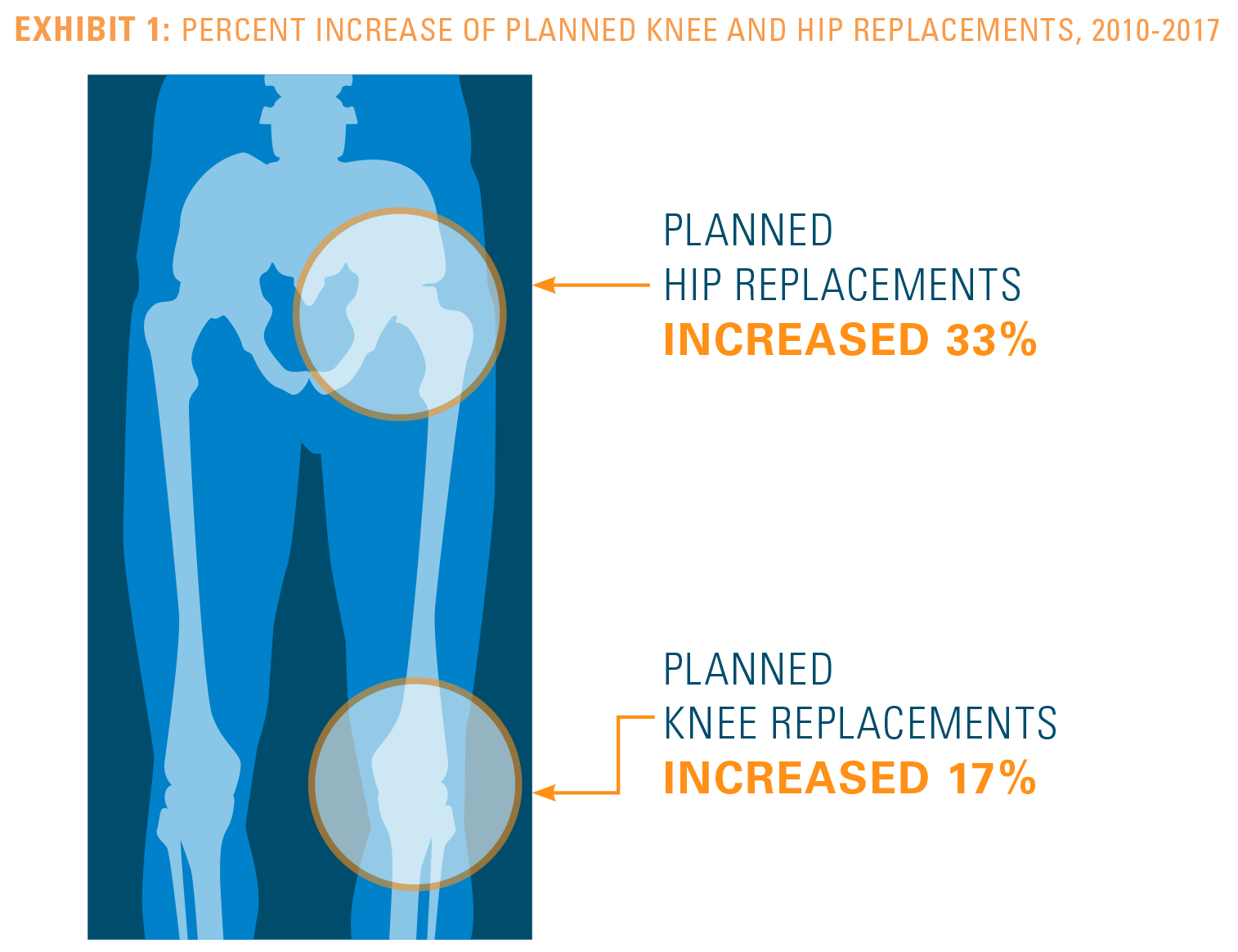
As expected, the largest increases for knee and hip procedures were among those within the 55 to 64 age group from 2010 to 2017. However, both procedures also grew among most of the younger age groups.
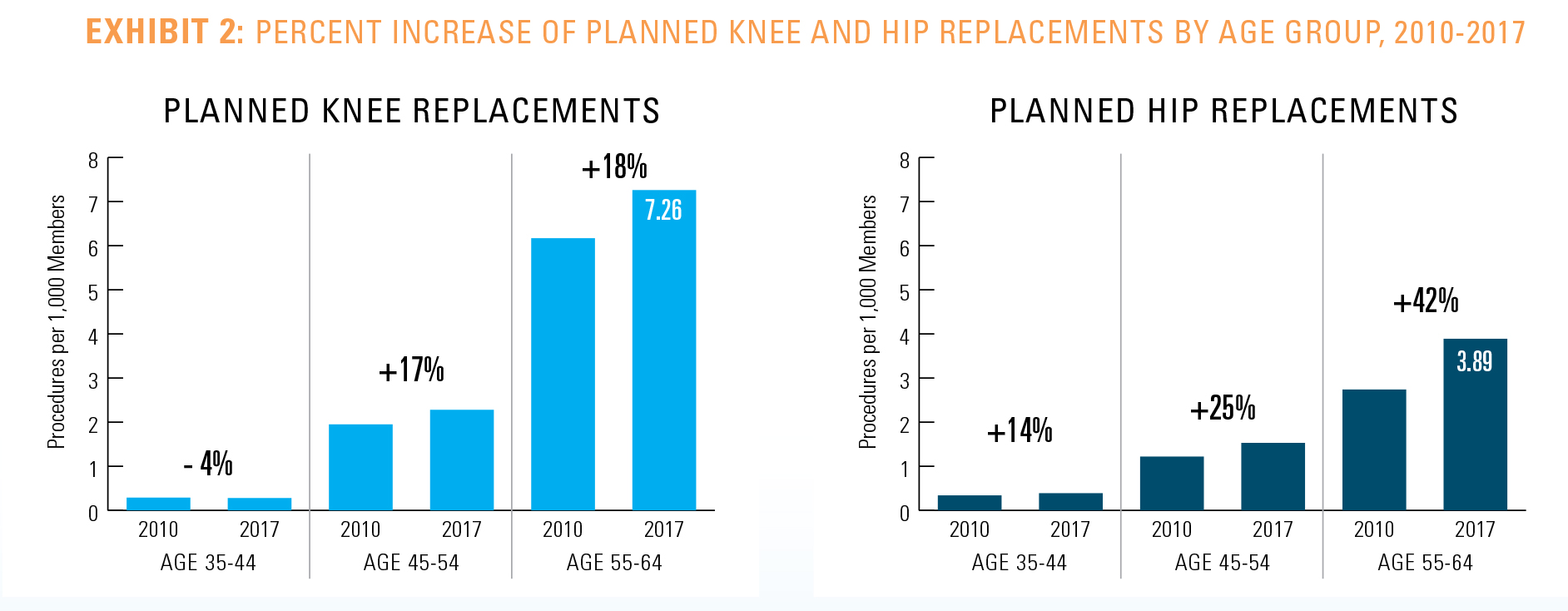
Improvements in Quality Outcomes
Inpatient
Complication rates for knee and hip procedures in the inpatient setting have improved over the past eight years—with rates down 29 percent for knee procedures and 32 percent for hip procedures.6 In addition, the average length of a hospital stay has also decreased for inpatient procedures since 2010. At the same time, prices for both knee and hip procedures continue to rise year-over-year.7
Outpatient
Complication rates for knee and hip procedures have also improved in the outpatient setting and, in fact, are below rates in the inpatient setting. Outpatient complication rates were down 23 percent for knee procedures and 36 percent for hip procedures from 2013 to 2017.8,9
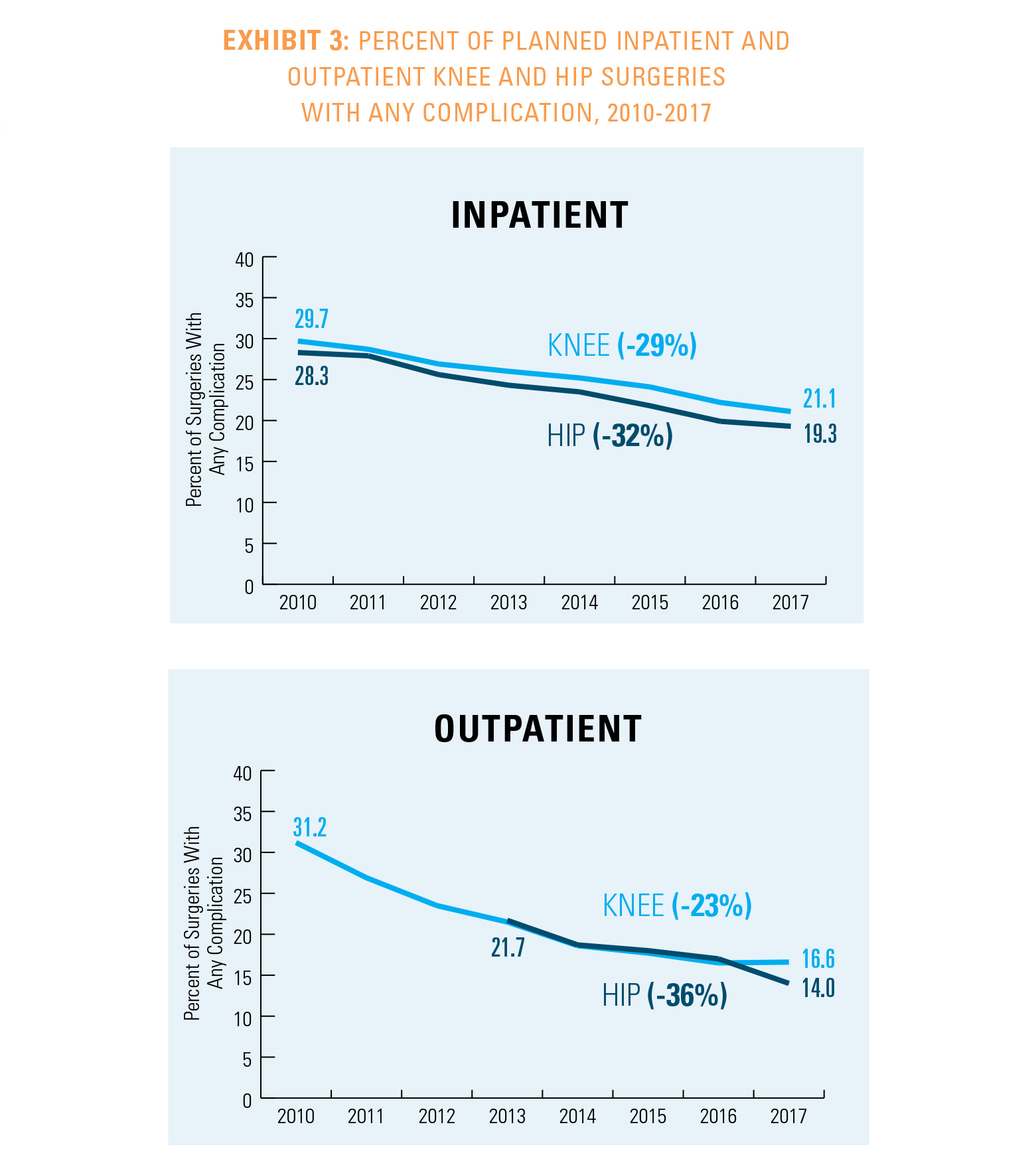
Utilization and Cost of Surgery
Planned knee and hip outpatient procedures are 30 to 40 percent less expensive on average than inpatient procedures.10 To emphasize the differences between costs in each care setting, the analysis in this section presents procedure prices incurred during the surgical visit.11
Across the country, the average cost for an inpatient knee replacement is $30,249, compared to $19,002 in the outpatient setting. For a hip replacement, the average cost in the inpatient setting is $30,685, compared to $22,078 in the outpatient setting.12
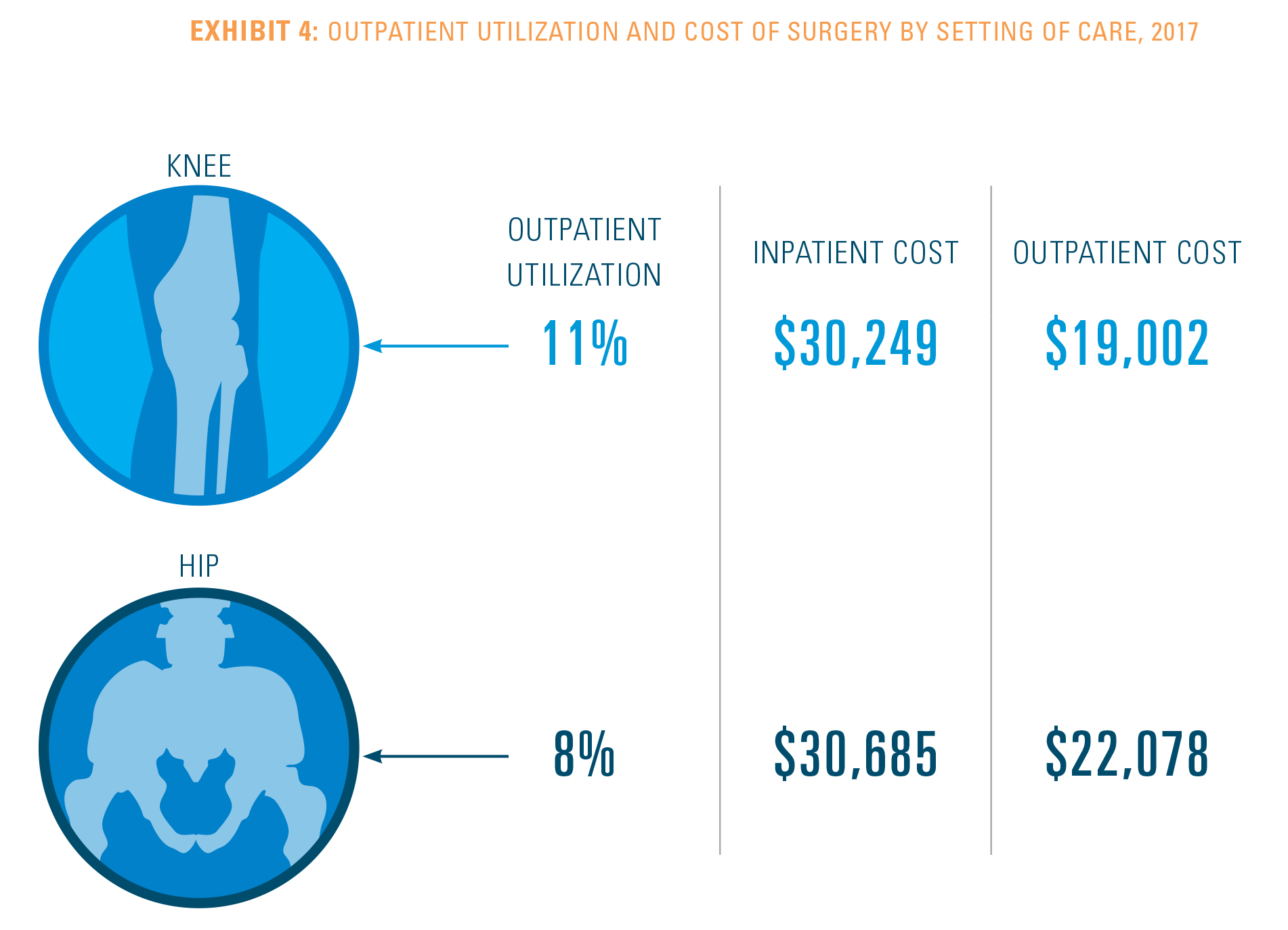
Access to outpatient facilities and the use of outpatient facilities for both knee and hip replacement procedures varies widely from state to state.13 For knee procedures, Alaska, Colorado, Georgia, Hawaii, Indiana, Kentucky, Minnesota, Mississippi and Ohio show outpatient surgery rates above 20 percent. For hip procedures, Alaska, Colorado, Minnesota and Mississippi have outpatient surgery rates above 20 percent.
Cost Transparency for Knee and Hip Replacements
Wide price variation continues to exist for orthopedic procedures across the U.S.14 In 2017, the national average price for a complete episode of orthopedic care was about $34,000, with average costs of $34,513 for inpatient knee replacements and $34,282 for inpatient hip replacements.15,16
Between MSAs, prices range three-fold—from an average low price of $19,934 and $19,263 for knee and hip procedures in Des Moines, Iowa, to an average high price of $61,750 and $64,641 for knee and hip surgeries in New York, N.Y.17 (See Appendices A, B and C for more information on costs by state and MSA.)
Price spreads within MSAs
Within the largest 100 MSAs, there is also typically a three- to four-fold difference between the highest priced and lowest priced episode of care ("price spread") for these surgeries. In fact, 30 of the largest MSAs have a price spread greater than $25,000 for knee and hip procedures.
In 2017, the greatest price spread for planned knee replacements occurred in San Antonio, ranging from $22,547 to $88,231 for the same episode of care—more than a three-fold price difference.
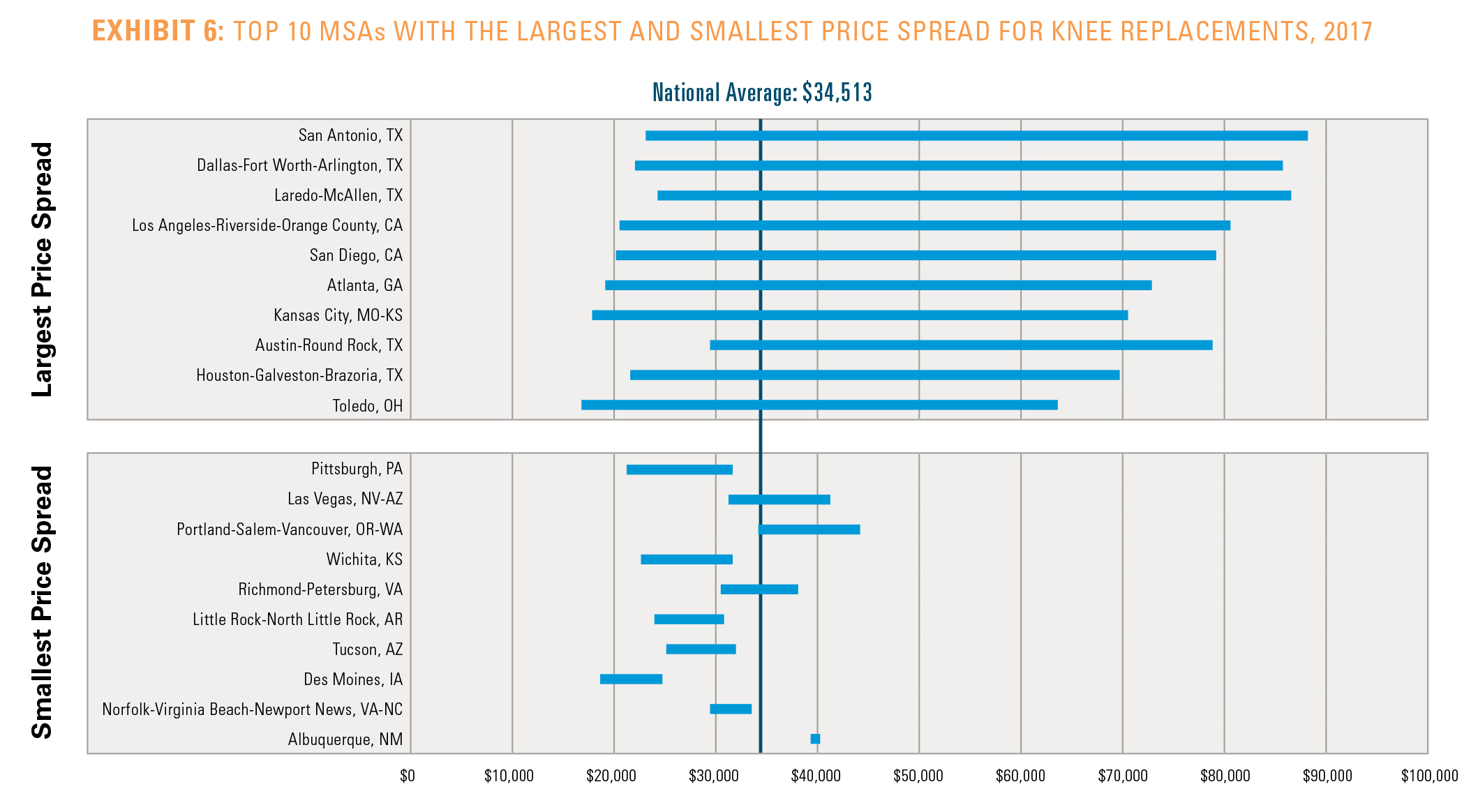 In 2017, Dallas had the greatest price spread for planned hip replacements, ranging from $20,597 to $98,638 for the same episode of care—more than a four-fold price difference.
In 2017, Dallas had the greatest price spread for planned hip replacements, ranging from $20,597 to $98,638 for the same episode of care—more than a four-fold price difference.
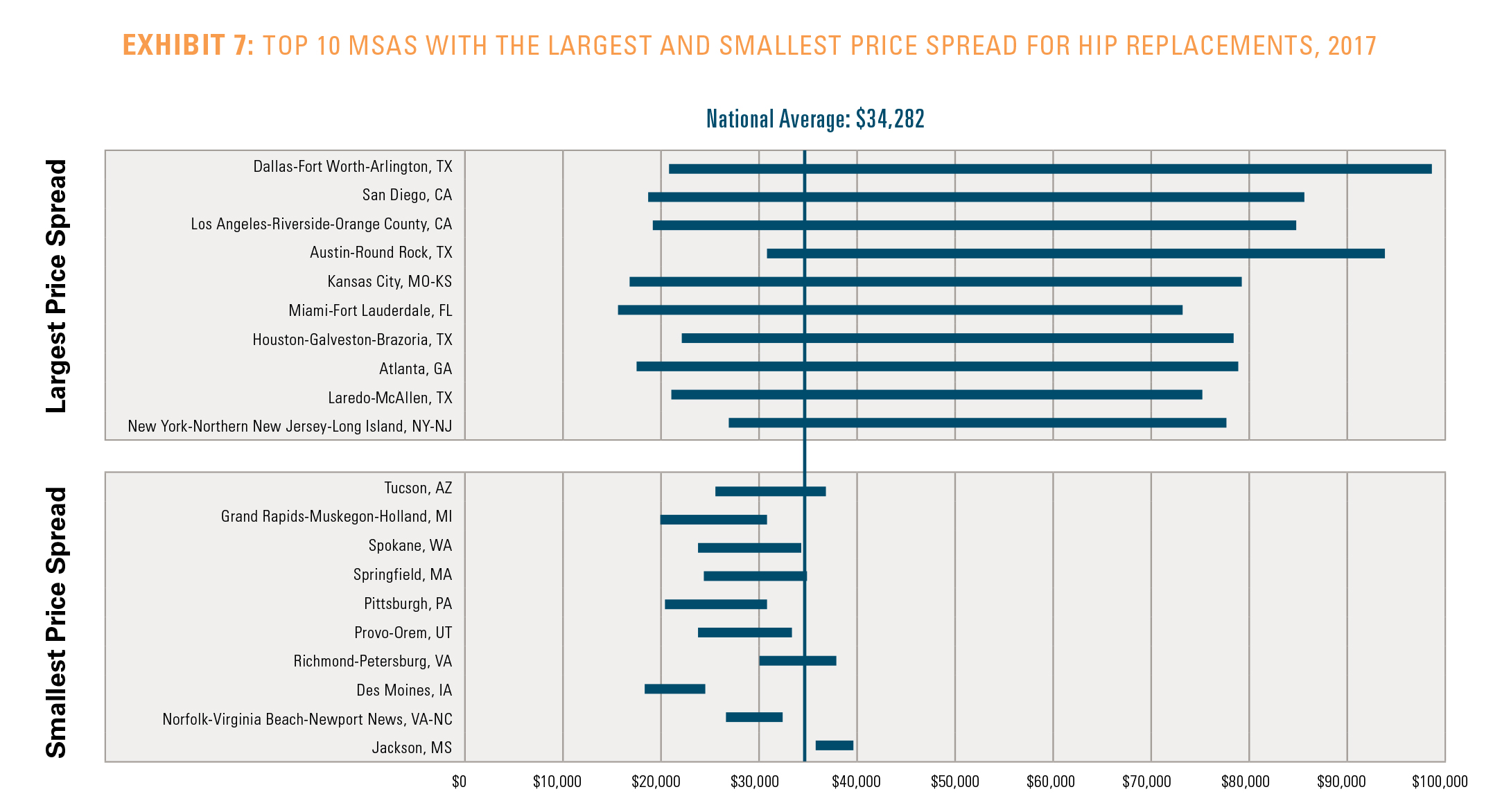
Conclusion
Planned knee and hip replacements are becoming more common among Americans, including people under age 55. Since orthopedic procedures have considerable price variation across the U.S., it is essential that individuals work with physicians to select a site of care that meets their needs for both quality and affordable costs. This report is based on analysis of data from BCBS Axis, the largest collection of commercial insurance claims data in the U.S. BCBS Axis was completed in 2015 to support cost transparency and data-driven decision making.
BCBS companies established Blue Distinction® Centers+, a national designation program recognizing healthcare facilities that demonstrate expertise in specific types of care—safely, effectively and cost-efficiently. Over 550 Blue Distinction Center+ for knee and hip replacement have been designated across the country to help Americans make informed choices about quality, cost-effective care.
Methodology
This is the 23rd study of the Blue Cross Blue Shield, The Health of America Report® series, a collaboration between Blue Cross Blue Shield Association (BCBSA) and Blue Health Intelligence (BHI), which uses a market-leading claims database to uncover key trends and insights in healthcare affordability and access to care. The report was done in partnership with HealthCore, a wholly owned and independently operated health outcomes subsidiary of Anthem, Inc.
This report identifies trends in cost and quality of care for elective or planned orthopedic surgical procedures (specifically knee and hip replacements) by examining the medical claims of more than 48 million Blue Cross and Blue Shield commercially insured members from 2010 through 2017.18 In this analysis, a knee replacement is defined as a total or partial knee replacement or a revision surgery. A hip replacement is defined as a total hip replacement or revision surgery. Inpatient settings include surgeries that are performed in a hospital, whereas outpatient settings include surgeries that are performed in an ambulatory surgery setting or dedicated hospital outpatient unit with no overnight stay.
Total spending amounts were extrapolated from the study population to the entire adult BCBS commercially insured population in 2017 and are adjusted for membership growth in prior years. All dollar amounts have been adjusted to reflect inflation and are presented in 2017 dollars.
In this report, overall orthopedic care costs include any of the following as they relate to musculoskeletal conditions: office visits, imaging tests, non-surgical treatments, planned surgeries and emergency surgeries. Prices for specific elective procedures are measured in two ways. Price at national, state and MSA levels are representative of an entire episode of care and include any tests or treatment in the year prior to surgery, the surgical procedure, device and professional fees and any physical therapy or prescriptions in the 60 days after surgery. For the inpatient to outpatient price comparison, costs before and after the surgery were stripped away to allow a "surgical visit" comparison between settings. This was done, in part, due to the need to obtain provider level pricing. The cost transparency section includes only episodes of care pricing at inpatient facilities due to low reporting volume for the outpatient setting.
All 50 states, the District of Columbia and the 100 most populous MSAs were analyzed, and results are presented in the Appendix. In some cases adjacent MSAs were combined to ensure sufficient data. All prices shown at the state and MSA levels were adjusted for cost of living using Medicare's Geographic Adjustment Factor.19
For more information and to read past reports from the Health of America Report series, visit www.bcbs.com/the-health-of-america
Appendix A: Price Spreads (2017)
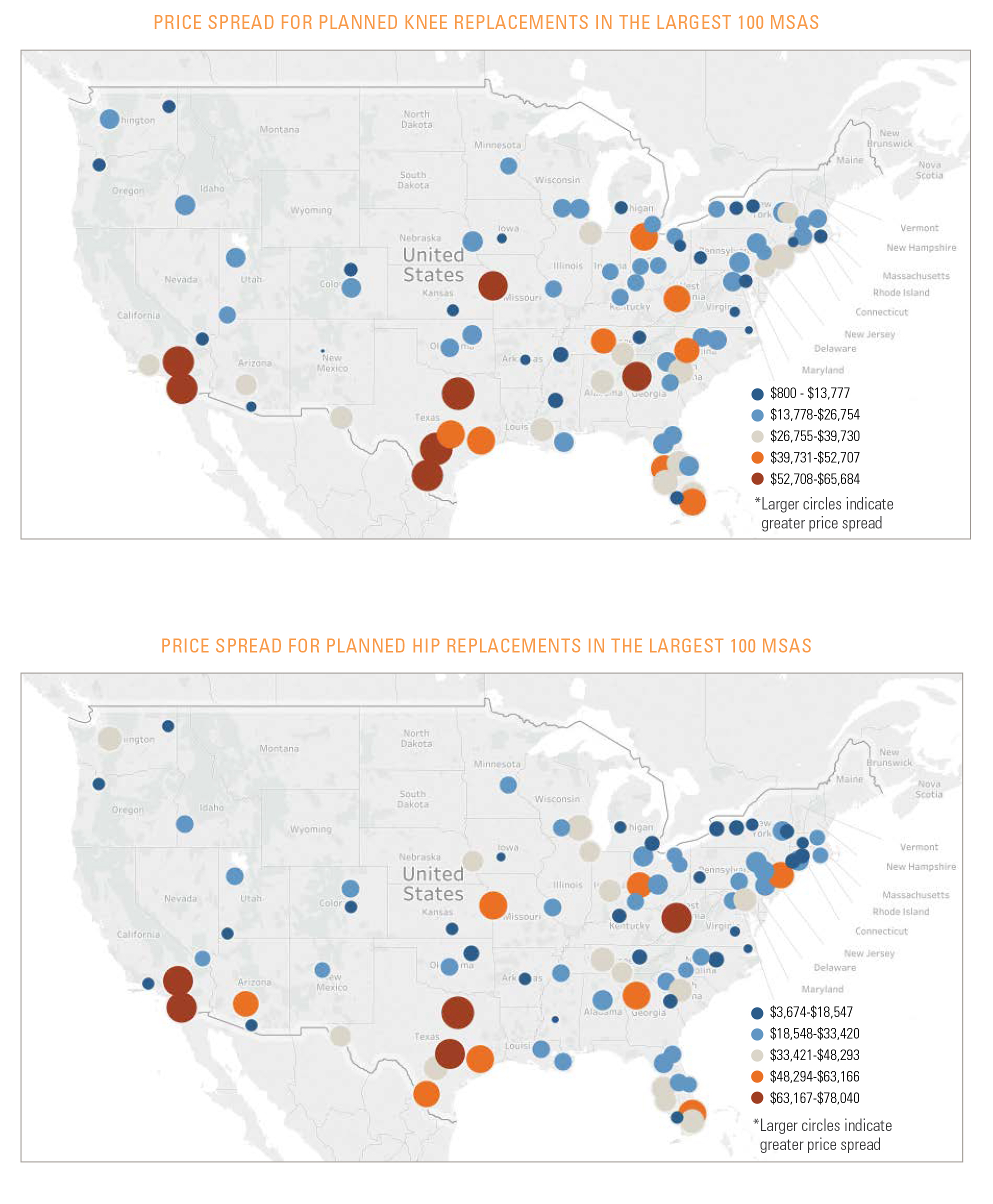
Appendix B:
Planned procedures by state (2010, 2017)
See Excel document
Appendix C:
Planned procedures by MSA (2010, 2017)
See Excel document
Appendix D:
Blue Distinction Centers+ (2018)
See Excel document
Footnotes
- In this report, orthopedic care includes office visits, imaging, pre-operative care, any surgical procedure, post-operative care, physical therapy and/or medication for musculoskeletal conditions. Overall spending on orthopedic care is based on data gathered from the Blue Cross Blue Shield Health IndexSM.
- In 2015, Blue Cross Blue Shield Association (BCBSA), in collaboration with Blue Health Intelligence (BHI), explored baseline trends in costs and utilization of knee and hip replacement surgeries: This new report updates cost and utilization trends and widens the scope to offer potential cost savings solutions for planned orthopedic surgeries.
- An elective procedure is a procedure planned in advance rather than a procedure performed in an emergency situation. Read more.
- Planned orthopedic surgeries include knee replacements, hip replacements, planned spine surgeries and other planned procedures. This report focuses on total and partial knee replacements, total hip replacements, and revision surgeries.
- Reasons often cited to account for the increase in planned knee and hip surgeries include improved implant technology and an increasing desire of Americans age 45 and older to remain active later in life. Read more.
- A procedure will be included in this measure if any of the following complications occurred during or within 90 days of the procedure: deep vein thrombosis, hematoma, joint dislocation, infections, pulmonary embolism, revision surgery or post-procedural hospitalization. If a surgery had multiple complications, it will only be counted once in this measure.
- Amounts adjusted to inflation for 2017.
- Outpatient data is insufficient prior to 2013 due to low volume utilization for hip replacements.
- Complication rates are not adjusted for case mix severity; therefore, caution should be used in comparing differences in rates between the inpatient and outpatient settings.
- This report examined outpatient procedures performed in either ambulatory surgery centers or a dedicated hospital outpatient department with no overnight stay.
- People who undergo inpatient or outpatient orthopedic surgeries may seek other types of treatments (including medications and physical therapy) in the one year before and within 60 days after surgery. Since costs before and after the surgery can be similar for either setting of care, price differences are mainly incurred during the surgical visit (including professional and facility fees, surgical procedure costs and hospital length of stay).
- Prices are not adjusted to account for differences in the case mix index.
- This report focuses on the under 65 commercially insured population. However, it is important to note that the Centers for Medicare & Medicaid Services (CMS) for 2018 removed knee replacement surgery from its "inpatient only" list. This change allows these procedures to be performed in hospital outpatient settings. Read more.
- In 2015, Blue Cross Blue Shield Association (BCBSA), in collaboration with Blue Health Intelligence (BHI), explored baseline trends in costs and utilization of knee and hip replacement surgeries. Read more.
- In this report, a complete episode of orthopedic care includes office visits, imaging, pre-operative care, any surgical procedure, post-operative care and physical therapy and/or medication for one year prior to surgery and 60 days post surgery.
- Only inpatient episodes of care were analyzed in this section of the report, as the bulk of orthopedic procedures are currently performed in the inpatient setting, demonstrating the price variation across and between MSAs.
- Average prices within all MSAs were adjusted for cost of living differences based on Medicare's Geographic Adjustment Factor (GAF) data.
- For more information on how musculoskeletal conditions can lead to both planned and emergency orthopedic surgeries, see AAOS.
- For more information, see CMS.gov.
Second Opinion: Knee Replacement
Watch the full episode
Second Opinion: Joint Replacement
Watch the full episode
ramboweireaddes2000.blogspot.com
Source: https://www.bcbs.com/the-health-of-america/reports/planned-knee-and-hip-replacement-surgeries-are-the-rise-the-us
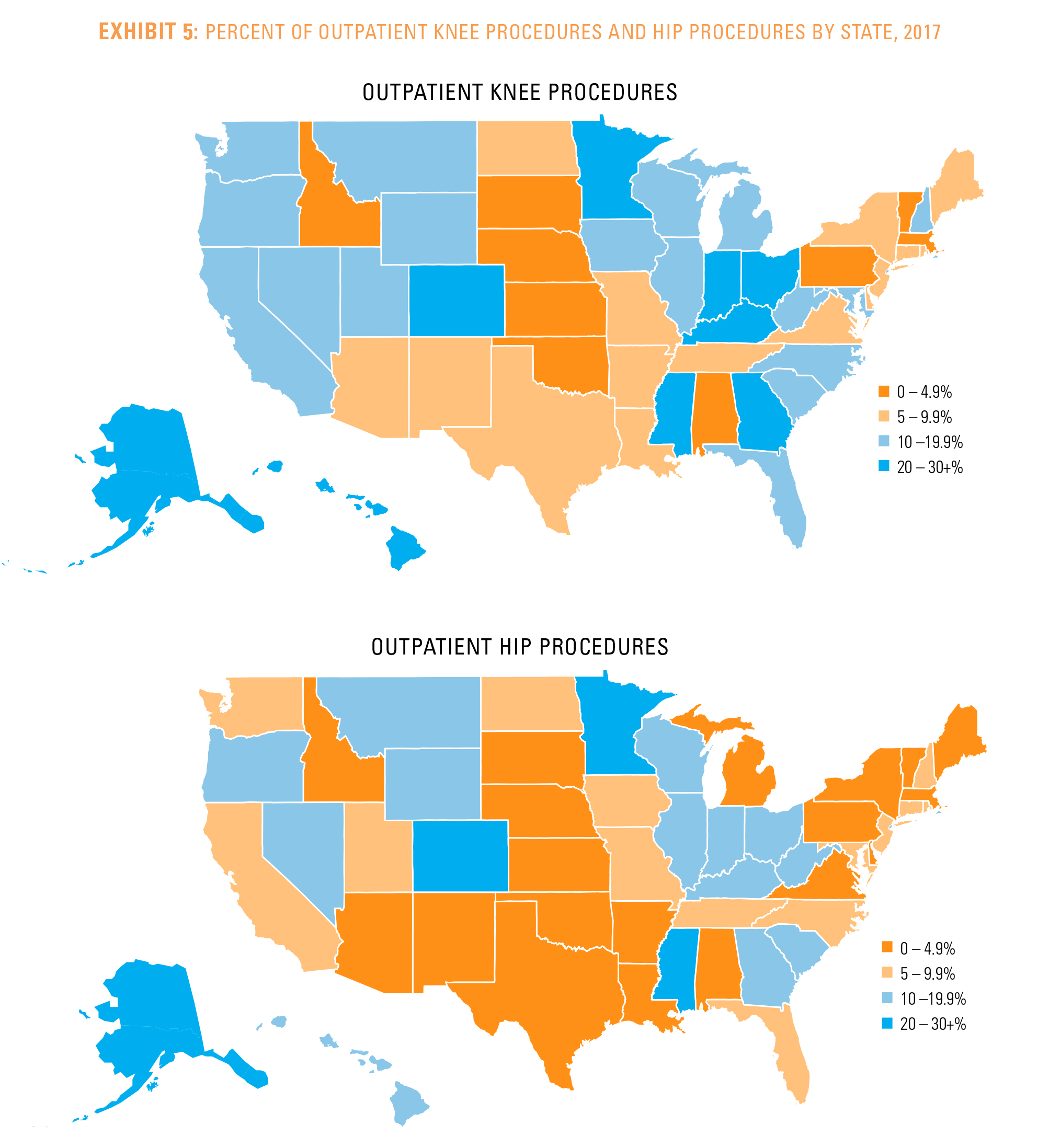

0 Response to "How Much Will a Knee Scooter Cst With My Nc Blue Cross Blue Shield"
Post a Comment